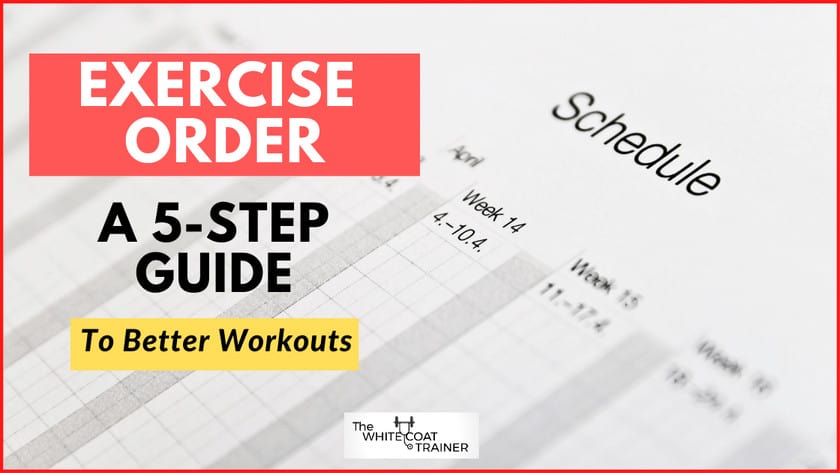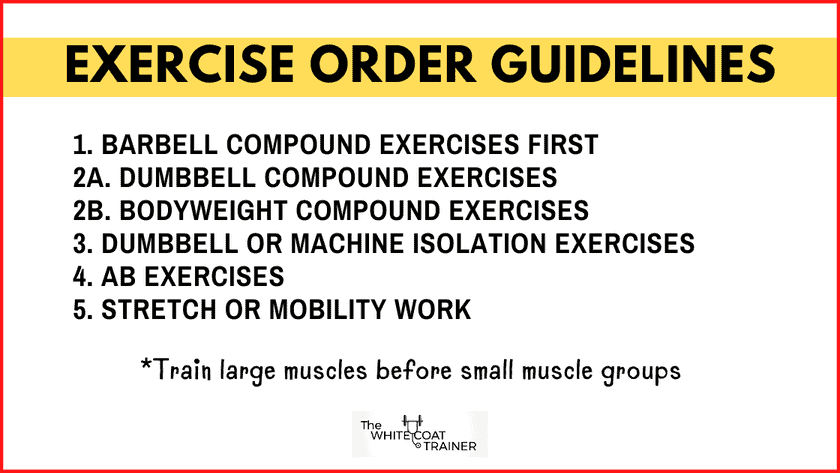Exercise order can have a significant impact on the results of your workout. The key is understanding which exercises you should prioritize so that you can make the most of your time and energy.
In this article, we will explore why exercise order matters and how to organize your training week for maximum gains.

Does Exercise Order Matter?
Yes – exercise order matters a lot. How you organize your workout can make a huge difference in your fitness gains.
In general, the best advice is to do the most difficult exercises at the start of your workout and the easier exercises later.
For example, compound (multi-joint) exercises that train large muscle groups should be the first exercises in a workout, as they require more energy than isolation (single-joint) exercises.
However, depending on your goals, this might not be the best exercise order for you.
Keep reading to learn more.
The Ideal Exercise Sequence
Here is a quick and dirty guide to an ideal order of exercise you might consider:
1. Barbell Compound exercises first (squats, bench presses, deadlifts)
2a. Dumbbell Compound exercises (dumbbell press, lunges)
2b. Bodyweight Compound exercises (pull-ups, dips)
3. Dumbbell or Machine Isolation exercises (lateral raises, tricep extensions)
4. Ab Exercises
5. Stretch or Mobility work
As you can see, compound, aka multi-joint exercises, take priority. These exercises involve multiple muscle groups, use more energy, and can stimulate greater growth.
Secondly, barbell exercises are the most demanding and should come before other movements. They are also the most difficult as they allow you to use heavier weights than dumbbells or machines.
Once you have completed the barbell exercises, you can focus on the dumbbell or bodyweight compound exercises.
Next, you can move on to isolation exercises. These single-joint movements target one muscle group at a time and use lighter weights.
Finally, feel free to stretch at the end of your workout to help cool down.
That said, remember that these are just general rules.

What If You Are Doing More Than One Exercise From Each Category?
What if your workout calls for three dumbbell compound movements on the same day?
Which one should you do first?
The guiding principle is:
Train larger muscle groups first before smaller muscle groups!
For example, squats train the quadriceps, adductors, spinal erectors, and glutes. Compare that to the shoulder press, which uses the deltoids and triceps.
Another example is the biceps. Biceps are a tiny muscle group compared to the larger back muscles. So, if you are doing both biceps curls and bent-over rows in your workout, do the bent-over row as the first exercise.
How To Organize Your Training Week (Weekly Workout Order)
Once you have your ideal exercise sequence down, it’s time to organize your training week.
To be perfectly honest, there is no ideal way to organize your week.
The most important thing is to make sure you divide your exercises in a way to give each muscle group enough time to recover.
I.e., give each muscle group ~48 hours of rest before working it again.
Personally, I like to follow an upper/lower workout split divided into four weekly workouts.
Here’s how a typical upper/lower split looks:
- Day 1 Upper Body
- Day 2 Lower Body
- Day 3 Rest Day
- Day 4 Upper Body
- Day 5 Lower Body
- Day 6 Rest Day
- Day 7 Rest Day
However, you can also use a full-body split:
- Day 1 Full Body Training
- Day 2 Rest Day
- Day 3 Full Body Training
- Day 4 Rest Day
- Day 5 Full Body Training
- Day 6 Rest Day
- Day 7 Rest Day
Lastly, you can also organize your workout into a push-pull-legs split:
- Day 1Push Day
- Day 2 Pull Day
- Day 3 Leg Day
- Day 4 Push Day
- Day 5 Pull Day
- Day 6 Leg Day
- Day 7 Rest Day
I cover several examples of all of these weight training splits here.

How To Choose Which Exercises To Prioritize First
When it comes to choosing exercises, there are a few factors to consider:
- Training Goal: Why are you training? Are you trying to get stronger, build muscle, or improve athletic performance? Depending on your goal, you may prioritize specific exercises over others.
- Muscle Groups: What muscle groups do you want to target? If you’re trying to build a particular muscle group, start with exercises that target it.
- Intensity: How intense do you want to go? High-intensity exercises require more energy, so they should be done first.
- Time: How much time do you have available for the workout? If your time is limited, prioritize compound exercises over isolation, as they give you the most bang for your buck.
Now let’s go into each of these in more detail.
The Ideal Exercise Order If Strength Is Your Goal
If your goal is to increase strength, do the specific compound exercises you want to improve first.
Common examples include:
– Squats
– Deadlifts
– Bench press
– Pull ups/chin ups
In addition, some compound exercises are more difficult than others.
For instance, the squat involves more focus and coordination than a bench press. So if you were doing both in the same workout, start with squats.
Here is an example full-body workout with an ideal exercise sequence for strength training:
- Squats 3 x 8 reps
- Bench Press 3 x 6 reps
- Pull-ups 3 x 8 reps
- Abs 3 x 12 reps
Now, what if you want to avoid using compound exercises?
Then prioritize the movement you want to strengthen the most.
A systematic review and meta analysis published in the Journal of Sports Science found that increases in muscular strength are greatest in the exercises performed first.
The Ideal Exercise Order If Building Muscle Is Your Goal
If your goal is to build muscle, focus your workouts on the particular muscle group you want to grow.
A typical example is chest and triceps on one day and back and biceps on another.
If you are including compound exercises in your workout, doing them first is a good idea. However, the order doesn’t matter as much if you are only using isolation exercises.
Here is an example upper-body workout with an ideal exercise sequence for muscle hypertrophy of the chest and triceps:
- Bench press 3 x 10 reps
- Incline Dumbbell Press 3 x 12 reps
- Dips 3 x 12 reps
- Triceps extensions 3 x 15 reps
Similarly, here’s one for lower body exercises.
- Barbell squat 3 x 8 reps
- Leg press 3 x 10 reps
- Leg extension 3 x 12 reps
- Calf raises 3 x 20 reps
The Benefits of Compound Exercises First
Compound exercises involve multiple muscle groups and joints working together, resulting in increased strength and power. Doing them first in your training session allows you to do these movements while you’re still fresh and energized.
This strategy will ensure that you can lift heavier weights or do more reps. In addition, doing compound movements first can help you focus on technique. Your risk of injury increases if you try to do complex exercises when you’re already fatigued.
Plus, focusing on proper form and technique takes a lot of mental energy.
The Benefits of Doing Isolation Exercises First
Isolation exercises are a great way to target specific muscles and induce hypertrophy in those areas.
Performing isolation exercises before compound exercise can be beneficial for pre-fatiguing and activating muscle groups that may be overlooked during the more complex movements.
As such, your muscles will already be tired, so you won’t be able to lift as heavy by the time you do the compound movement. This pre-exhaust technique may be beneficial if your goal is muscle growth and not strength.
Key Takeaway
Overall, both isolation and compound exercises have their place in an effective workout routine. Prioritize the body part and exercise you care most about and place them at the beginning of the workout.
What About Cardio and Aerobic Exercise?
So when should you do your cardio or aerobic exercises? It ultimately comes down to personal preference and what works best for you.
If you want to lose weight or build endurance quickly, prioritizing cardio before your resistance training may be the way to go.
However, if you care more about building strength and muscle, it’s better to do your cardio or aerobic activities after or on a separate day altogether.
Just make sure not to place a high-intensity cardio day near a day in which you train your legs.
A Quick Word On Circuit Training
Circuit training combines multiple exercises into one workout session, usually with little to no rest between sets.
When completing a circuit, the same rules apply. If there are any exercises you deem most important, do those first while you are still fresh.
Sample Full Body Workout Sequence
If you are a beginner looking for a sample full-body workout with an ideal exercise order, here is a template you can use:
Example Day 1:
- Squat, 3 sets of 6-12 reps
- Push-ups, 3 sets of 8-12 reps
- Walking Lunges, 3 sets of 8-12 reps
- Mobility
Example Day 2:
- Low Incline Bench Press, 3 sets of 6-12 reps
- Goblet Squat, 3 sets of 8-12 reps
- Dumbbell Overhead Press, 3 sets of 8-12 reps
- Mobility
Example Day 3:
- Romanian Deadlift, 3 sets of 6-12 reps
- Dumbbell Bench Press, 3 sets of 8-12 reps
- Back Raises, 3 sets of 8-12 reps
- Mobility
Example Day 4:
- Overhead Press, 3 sets of 6-12 reps
- Single Leg RDL, 3 sets of 8-12 reps
- Pull-ups, 3 sets of 8-12 reps
- Mobility
Learn more on how to choose sets and repetitions here.
You can do light aerobic activities like swimming, jogging, or cycling on your off days. You can also include core exercises to round out your workout.
If you need help with a complete step-by-step done-for-you gym workout and nutrition program, you should check out The WCT Strength Program. A 15-week training program designed by two busy doctors to help you build strength, improve your health, and maximize your longevity in just 30 minutes a day.

You can learn more about our Strength Program here!
Final Words On Exercise Order
An ideal exercise sequence is essential to maximize the effectiveness of your workout.
A simple set of rules is prioritizing compound exercises before isolation exercises and training large muscles before small muscles.
However, it is perfectly reasonable to follow the opposite order if it works better for you and your goals.
Research shows that the greatest strength gains occur in the movements you do first.
Now I want to hear from you.
Do you think this is the best way to organize your workout routines?
What’s your workout sequence like?
Let me know in the comment section below.

Alex Robles, MD, CPT / Brittany Robles, MD, MPH, CPT
Alex & Brittany Robles are physicians, NASM Certified Personal Trainers, and founders of The White Coat Trainer: a resource dedicated to improving the health and fitness of busy professionals using time-efficient strategies. Their advice has been featured in My Fitness Pal, Prevention, Livestrong, Reader’s Digest, Bustle, The Active Times, and more. Learn more about them here.
References:
- Nunes JP, Grgic J, Cunha PM, Ribeiro AS, Schoenfeld BJ, de Salles BF, Cyrino ES. What influence does resistance exercise order have on muscular strength gains and muscle hypertrophy? A systematic review and meta-analysis. Eur J Sport Sci. 2021 Feb;21(2):149-157. doi: 10.1080/17461391.2020.1733672. Epub 2020 Feb 28. PMID: 32077380.

Hi Alex and Brittany,
Thank you for the nice article and the free PDF. I’ve been training for probably 30 years. I’m 65 years old. And I’ve discovered that the best way to work out for me, which is at my home gym, is to do a full body workout every day. That would include every muscle group. My main exercises, I do first -pull ups and dips. Then from there it varies what I do. I mix it up. I also include many postural stretches, and exercises for strength.
I know you’re gonna say that there’s no time for rest in between there. But I don’t always go to failure at every set. And I super set or double set as much as possible.. I’ve been following a Jeff Nippard program. And in this workout fashion if you miss a day, it’s no big deal. There’s always a day where we need to skip the work out that day.
Thanks again for the article and I will look forward to your next email.
Thanks, Sal.
Thanks for your comment Sal – I actually think that’s a good plan! It is feasible to exercise every day, provided you modulate the intensity and are able to recover from the workload!
Today’s article really has me thinking. I had been doing a full-body, three day a week, each day an horizontal and vertical push and pull (4 total), a lower body exercise (hip hinge, squat, lunge), and a core. Six exercises in total. Then I moved to 4 days a week, (A) 2 push (horiz and vert), core and lower, and then (B) 2 pull, core and lower. Again, six exercises per day.
With this and accompanying pieces, as well as the PDF, I’m now thinking that I might be okay with a four-day workout of 2 upper compound exercises and one lower, plus core (four exercises per day). Am I understanding this correctly?
I’m really just trying to stay healthy, not great strength or size. Thanks!
Absolutely. I think your new plan sounds very reasonable and very sustainable. At the end of the day, the sustainability piece is going to be the most important aspect to any fitness program. As long as you are doing the core exercises regularly, and you are providing a well thought out sequence and progressive overload component, the second option there seems to be easier to stick to!